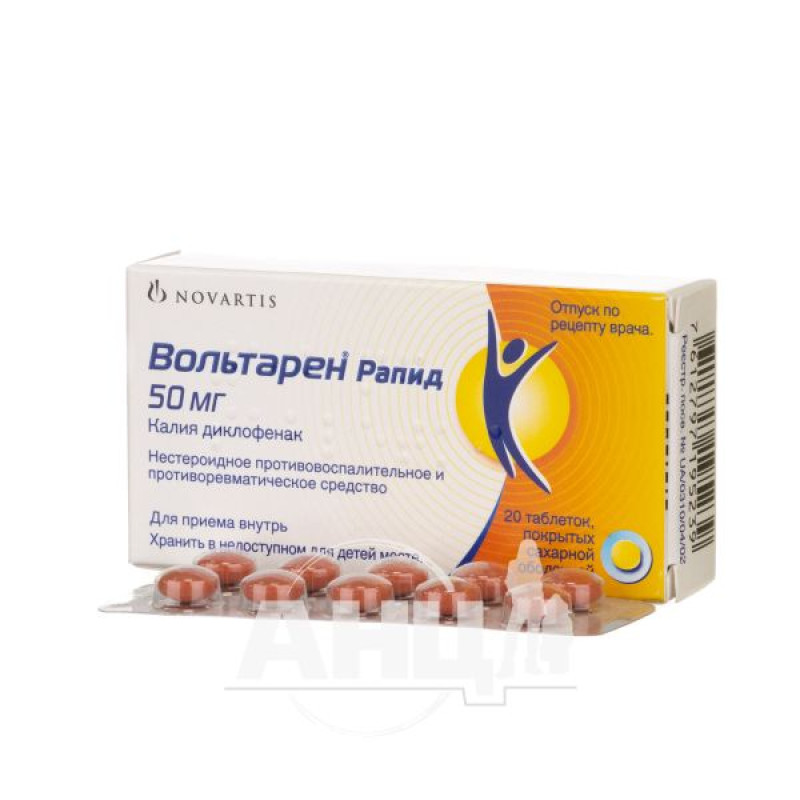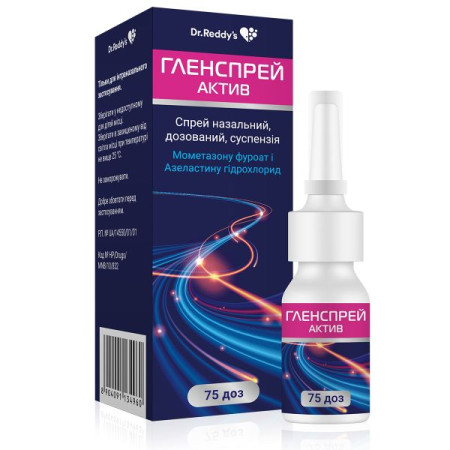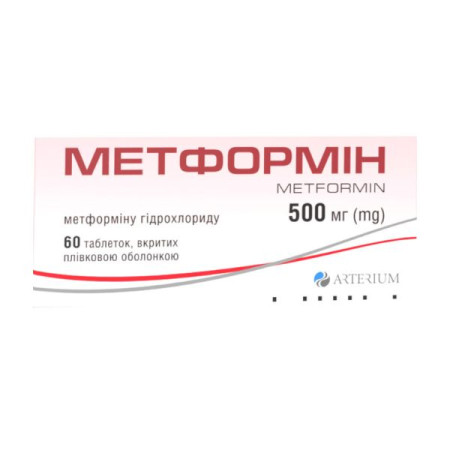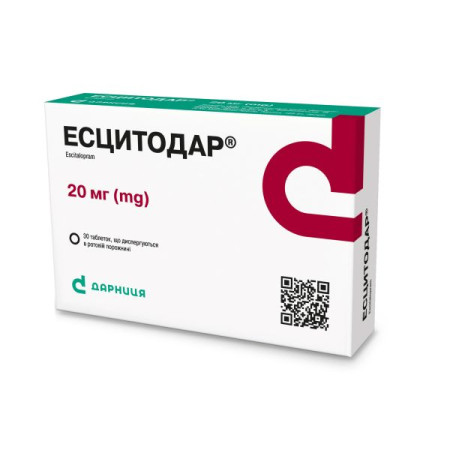Voltaren Rapid sugar-coated tablets 50 mg No. 20
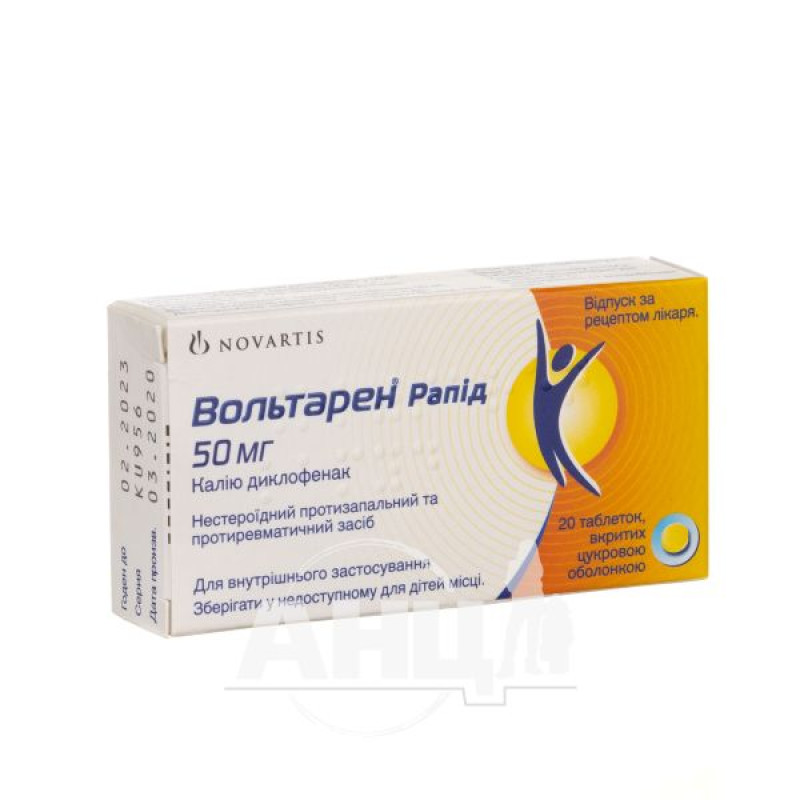
Instructions Voltaren Rapid sugar-coated tablets 50 mg No. 20
Composition
active ingredient: diclofenac;
1 tablet contains diclofenac potassium 25 mg or 50 mg;
excipients: internal contents of the tablet – colloidal anhydrous silicon dioxide, calcium phosphate, magnesium stearate, corn starch, povidone, sodium starch glycolate (type A);
tablet coating – microcrystalline cellulose, red iron oxide (E 172), titanium dioxide (E 171), povidone, polyethylene glycol 8000, sucrose, talc.
Dosage form
Sugar-coated tablets.
Main physicochemical properties:
50 mg tablets – red-brown, round, biconvex tablets, coated with a sugar coating.
25 mg tablets – pale red, round, biconvex tablets, coated with a sugar coating.
Pharmacotherapeutic group
Nonsteroidal anti-inflammatory and antirheumatic drugs. Acetic acid derivatives and related compounds. ATC code M01A B05.
Pharmacological properties
Pharmacodynamics.
Diclofenac, the active ingredient of Voltaren® Rapid, is a non-steroidal anti-inflammatory drug (NSAID) with pronounced analgesic, anti-inflammatory and antipyretic effects. The main mechanism of action is the inhibition of the biosynthesis of prostaglandins, which play a major role in the occurrence of inflammation, pain and fever.
In vitro, at concentrations equivalent to those achieved in humans, diclofenac does not inhibit proteoglycan biosynthesis in cartilage tissue.
Voltaren® Rapid tablets, due to their rapid absorption, are suitable for the treatment of acute conditions accompanied by pain and inflammation, in which a rapid onset of action of the drug (within 30 minutes) is desirable. In post-traumatic pain and inflammation, diclofenac quickly relieves both spontaneous pain and pain on movement, and also reduces swelling in inflammation and swelling in the wound area.
In addition, the active substance can relieve pain and reduce bleeding in primary dysmenorrhea. Diclofenac also provides analgesic effects in other conditions accompanied by moderate to severe pain.
Pharmacokinetics.
Absorption.
Diclofenac is rapidly and completely absorbed. Absorption begins immediately after administration of the drug, and the amount of substance absorbed corresponds to the amount absorbed when taking an equivalent dose of diclofenac sodium, used in the form of gastro-resistant tablets. The average maximum concentration in the blood plasma is 3.8 μmol/l and is reached within 20-60 minutes after administration of a 50 mg tablet. When the drug is used with food, there is no effect on the amount of absorbed diclofenac, although the onset and rate of absorption may be somewhat delayed.
Distribution.
Diclofenac is 99.7% bound to serum proteins, mainly albumin (99.4%). The volume of distribution is 0.12-0.17 l/kg.
Diclofenac penetrates into the synovial fluid, where its maximum concentrations are reached 2-4 hours after reaching peak values in the blood plasma. The apparent half-life from the synovial fluid is 3-6 hours. 2 hours after reaching peak levels in the blood plasma, the concentrations of the active substance in the synovial fluid are higher than in the plasma, and remain so for another 12 hours.
Biotransformation.
The biotransformation of diclofenac occurs partly by glucuronidation of the intact molecule, but mainly by single and multiple hydroxylation and methoxylation, resulting in the formation of several phenolic metabolites (3'-hydroxy-, 4'-hydroxy-, 5'-hydroxy-, 4',5-dihydroxy- and 3'-hydroxy-4'-methoxy-diclofenac), most of which are subsequently converted to glucuronide conjugates. Two of these phenolic metabolites are pharmacologically active, but to a much lesser extent than diclofenac.
Breeding.
The total systemic clearance of diclofenac from plasma is 263 ± 56 ml/min (mean ± standard deviation). The terminal half-life is 1-2 hours. The half-life of the 4 metabolites, including 2 active ones, is 1-3 hours. The virtually inactive metabolite, 3'-hydroxy-4'-methoxy-diclofenac, has a much longer half-life.
Approximately 60% of the dose is excreted in the urine as metabolites, and less than 1% as unchanged drug. The remainder of the dose is excreted as metabolites in the bile and feces.
Pharmacokinetics in certain patient groups.
No significant differences in absorption, metabolism, and excretion of the drug were observed depending on the patient's age.
In patients with impaired renal function, the kinetics of a single dose of the drug do not indicate the existence of any form of accumulation of unchanged active substance under the usual regimen of use of the drug. In patients with creatinine clearance less than 10 ml/min, the theoretical equilibrium concentrations of metabolites in plasma are approximately 4 times higher than in healthy patients. However, these metabolites are ultimately excreted in the bile.
Indication
Voltaren® Rapid 25 mg and 50 mg
Short-term treatment (maximum 2 weeks) of the following acute conditions:
• post-traumatic pain, inflammation and swelling, for example, due to sprains;
• pain and/or inflammation accompanying inflammatory gynecological diseases, such as primary dysmenorrhea or adnexitis;
• pain syndromes in the spine;
• rheumatic diseases of extra-articular tissues;
• as an adjuvant for infections of the ENT organs, for example, pharyngotonsillitis, otitis media, accompanied by severe pain and inflammation.
Voltaren® Rapid 50 mg for adult patients
• migraine attacks with or without precursors.
In accordance with generally accepted approaches to the treatment of infectious and inflammatory diseases, it is also necessary to use etiotropic agents. Isolated fever is not an indication for the use of Voltaren® Rapid.
Contraindication
• Hypersensitivity to the active substance or to any other components of the drug;
• History of allergic reactions in the form of bronchospasm, urticaria, acute rhinitis, nasal polyps or allergy-like symptoms after using acetylsalicylic acid or other nonsteroidal anti-inflammatory drugs;
• Gastric ulcer and/or duodenal ulcers, gastrointestinal bleeding or perforation;
• Inflammatory bowel disease (Crohn's disease or ulcerative colitis);
• Severe liver failure (Child-Pugh class C, cirrhosis and ascites).
• Severe renal failure (creatinine clearance < 30 ml/min);
• Congestive heart failure (NYHA II-IV);
• Treatment of perioperative pain during coronary artery bypass grafting (or use of a cardiopulmonary bypass machine);
• Ischemic heart disease in patients with angina pectoris who have had a myocardial infarction;
• Cerebrovascular disease in patients who have had a stroke or have episodes of transient ischemic attacks;
• Peripheral arterial disease.
Interaction with other medicinal products and other types of interactions
The following interactions have been observed with Voltaren® Rapid and/or other doses and forms of diclofenac.
Lithium: Diclofenac may increase plasma lithium concentrations when used concomitantly. Monitoring of serum lithium levels is recommended.
Digoxin: Diclofenac may increase plasma digoxin concentrations when used concomitantly. Monitoring of serum digoxin levels is recommended.
Diuretics and antihypertensives. As with other NSAIDs, concomitant use of diclofenac and diuretics or antihypertensives (e.g. beta-blockers, angiotensin-converting enzyme (ACE) inhibitors) may lead to a reduction in the antihypertensive effect. Therefore, the combination of these drugs should be used with caution; and patients, especially the elderly, should have their blood pressure monitored periodically. Patients should be adequately hydrated and renal function should be monitored after initiation of combination therapy and regularly thereafter, especially when diuretics and ACE inhibitors are used due to the increased risk of nephrotoxicity. Concomitant treatment with potassium-sparing diuretics may lead to an increase in serum potassium, so potassium levels should be monitored regularly.
Other NSAIDs and corticosteroids: Concomitant use of diclofenac with other systemic NSAIDs or corticosteroids may increase the incidence of gastrointestinal adverse reactions.
Anticoagulants and antithrombotic agents should be administered with caution, as concomitant use with diclofenac may increase the risk of bleeding. Although clinical studies do not indicate that diclofenac affects the action of anticoagulants, there are isolated reports of an increased risk of bleeding in patients receiving diclofenac and anticoagulants simultaneously. Regular monitoring of such patients is recommended.
Selective serotonin reuptake inhibitors (SSRIs): Concomitant administration of systemic NSAIDs, including diclofenac, and SSRIs may increase the risk of gastrointestinal bleeding.
Antidiabetic agents. Clinical studies have shown that diclofenac can be administered concomitantly with oral antidiabetic agents without affecting their clinical effect. However, there have been isolated reports of hyperglycemia and hypoglycemia, requiring dose adjustment of antidiabetic agents. Monitoring of blood glucose levels is recommended during combination therapy.
Methotrexate: NSAIDs should be used with caution at least 24 hours before or after treatment with methotrexate, as blood concentrations of methotrexate may increase and increase toxicity.
Cyclosporine: Diclofenac, like other NSAIDs, may increase the nephrotoxicity of cyclosporine due to its effects on renal prostaglandins. Therefore, diclofenac should be used at lower doses than in patients not taking cyclosporine.
Quinolone antibiotics: There have been isolated reports of convulsions, which may be associated with the concomitant use of quinolones and NSAIDs.
Phenytoin: When using phenytoin concomitantly with diclofenac, it is recommended to monitor phenytoin plasma concentrations due to a possible increase in phenytoin exposure.
Application features
- General.
The concomitant use of Voltaren® Rapid and other systemic NSAIDs, including selective COX-2 inhibitors, should be avoided, as there is no evidence of synergistic benefits and because of the occurrence of additional side effects.
As with all analgesics, prolonged use of the drug for the treatment of headache may result in improvement or worsening of the condition (medication overuse headache). If the headache is due to analgesic overuse, the dose of the analgesic should not be increased, and in such cases the treatment should be discontinued. Medication overuse headache should be suspected in patients with frequent or daily attacks of headache that occur despite (or because of) regular analgesic use.
As with other NSAIDs, allergic reactions (including anaphylactic/anaphylactoid reactions) may rarely occur, even without prior use of diclofenac.
Like other NSAIDs, Voltaren® Rapid, due to its pharmacodynamic properties, may mask the signs and symptoms of infection.
The drug should be used with caution in patients over 65 years of age. In particular, it is recommended to prescribe the lowest effective doses in physically frail elderly patients or if the patient's body weight is below normal.
Voltaren® Rapid tablets contain sucrose and are therefore not recommended for patients with rare hereditary forms of fructose intolerance, glucose-galactose malabsorption or sucrase-isomaltase insufficiency.
- History of asthma.
Patients with asthma, seasonal allergic rhinitis, nasal mucosal edema (e.g., nasal polyps), chronic obstructive pulmonary disease (COPD), or chronic respiratory tract infections (especially with manifestations similar to symptoms of allergic rhinitis) are more likely than other patients to experience side effects such as exacerbation of asthma (so-called analgesic intolerance or analgesic asthma), angioedema, and urticaria when taking NSAIDs. Therefore, special precautions (emergency medical attention) are necessary for such patients. The above also applies to patients with allergic manifestations when using other drugs, e.g., rash, itching, urticaria.
- Effects on the gastrointestinal tract (GI).
As with other NSAIDs, close medical supervision and special caution are necessary when prescribing Voltaren® Rapid to patients with symptoms suggestive of gastrointestinal disorders or with a history of ulcer, bleeding or perforation of the stomach or intestines. The risk of gastrointestinal bleeding increases with increasing NSAID doses, as well as in patients with a history of ulcer, especially if complicated (bleeding or perforation), and in elderly patients. To reduce the risk of gastrointestinal toxicity in such patients, treatment should be initiated and maintained at the lowest effective dose. For such patients, as well as for patients who require concomitant use of acetylsalicylic acid-containing drugs or other drugs that increase the risk of gastrointestinal toxicity, the possibility of prescribing combination therapy with protective agents (e.g. proton pump inhibitors or misoprostol) should be considered.
Patients with a history of gastrointestinal toxicity, especially the elderly, should report any unusual abdominal symptoms (especially gastrointestinal bleeding) to their physician. Caution should be exercised when prescribing the drug to patients who are concomitantly taking medications that may increase the risk of ulceration or bleeding (systemic corticosteroids, anticoagulants, antithrombotic agents, or selective serotonin reuptake inhibitors).
- Effect on the liver.
Patients with liver disorders should be monitored closely as their condition may worsen.
As with other NSAIDs, levels of one or more liver enzymes may increase.
It should be noted that Voltaren® Rapid is recommended only for short-term treatment (no more than 2 weeks). In the case of long-term use of diclofenac, regular monitoring of liver function is a precautionary measure. The use of this drug should be discontinued if liver function is impaired or worsened, if clinical signs or symptoms suggestive of liver disease develop, or if other symptoms occur, such as eosinophilia, rash. Hepatitis may occur without prodromal symptoms.
In addition to elevated liver enzymes, severe hepatic reactions, including jaundice and fulminant hepatitis, hepatic necrosis and hepatic failure, some of which were fatal, have been reported rarely.
Diclofenac should be used with caution in patients with hepatic porphyria due to the possibility of provoking an attack.
- Effect on the kidneys.
Long-term use of high doses of NSAIDs often (1-10%) leads to edema and arterial hypertension.
Particular caution should be exercised in patients with cardiac or renal impairment, a history of hypertension, elderly patients, patients who are concomitantly taking diuretics or drugs that may significantly affect renal function, and patients with significant volume depletion, e.g. before/after surgery. When prescribing Voltaren® Rapid in such cases, renal function should be monitored. After discontinuation of therapy, the patient's condition usually returns to normal.
- Cardiovascular and cerebrovascular effects.
Diclofenac should only be prescribed to patients with significant risk factors for cardiovascular events (such as hypertension, hyperlipidemia, diabetes mellitus, smoking) after careful clinical evaluation. Since the cardiovascular risks of diclofenac may increase with increasing dose and duration of treatment, it should be used for the shortest possible period and at the lowest effective dose. The patient's need for diclofenac to relieve symptoms and the response to therapy should be periodically reviewed.
- Effect on hematological parameters.
Voltaren® Rapid is recommended for short-term treatment only. If this drug is prescribed for a longer period, it is recommended (as with other NSAIDs) to regularly monitor the blood count.
Like other NSAIDs, diclofenac may temporarily inhibit platelet aggregation, so patients with impaired hemostasis should be carefully monitored.
- Skin reactions.
Serious skin reactions (in some cases fatal), including exfoliative dermatitis, Stevens-Johnson syndrome and toxic epidermal necrolysis, have been reported very rarely in association with the use of NSAIDs, including Voltaren® Rapid. Patients are at greatest risk of developing such reactions at the beginning of treatment, and the onset of these reactions usually occurs within the first month of treatment. Voltaren® Rapid should be discontinued at the first appearance of rash, mucosal lesions or any other sign of hypersensitivity.
Use during pregnancy or breastfeeding
Pregnancy.
Animal studies do not indicate direct or indirect toxic effects with respect to pregnancy, embryonal/fetal development, parturition or postnatal development.
Diclofenac has not been studied in pregnant women. Voltaren® Rapid should not be used during the first two trimesters of pregnancy unless the potential benefit to the mother outweighs the risk to the fetus. Use of the drug during the third trimester of pregnancy is contraindicated because of the possibility of inhibition of labor and premature closure of the ductus arteriosus.
Breast-feeding.
Like other NSAIDs, diclofenac passes into breast milk in small amounts, so Voltaren® Rapid should not be prescribed during breastfeeding to avoid the development of side effects in the child.
Fertility.
Like other NSAIDs, Voltaren® Rapid may affect female fertility and is therefore not recommended in women attempting to conceive. The drug should be discontinued in women who are unable to conceive or in women undergoing investigation for infertility.
Ability to influence reaction speed when driving vehicles or other mechanisms
Usually, when taking the drug in the recommended dose and with a short course of treatment, there is no effect on the speed of reactions. However, patients who experience visual disturbances, dizziness, vertigo, drowsiness or other disorders of the central nervous system (CNS) when using Voltaren® Rapid should not drive or operate machinery.
Method of administration and doses
The drug should be used in the lowest effective doses for the shortest period of time, taking into account the treatment objectives of each individual patient.
The tablets should be swallowed whole, without chewing, with water, preferably before meals.
For adults, the recommended dose is 100-150 mg per day. In case of moderate symptoms, a dose of 75-100 mg per day is usually sufficient. The daily dose should be divided into 2-3 doses.
In primary dysmenorrhea, the daily dose of Voltaren Rapid should be selected individually. The daily dose is usually 50-100 mg. If necessary, during the next few menstrual cycles, the dose is increased to a maximum of 200 mg per day. The use of Voltaren Rapid tablets should be started at the first symptoms and continued for several days depending on the response and symptoms.
Migraine
The drug should be used at the first signs of an attack. The recommended single dose of the drug is 50 mg. The next 50 mg can be used 2 hours after the first dose. If necessary, the drug can be continued after 4-6 hours, but it should be remembered that the maximum dose of the drug is 200 mg per day.
Children.
The drug is not recommended for children under 14 years of age due to the high content of the active substance.
Overdose
Symptoms. There is no typical clinical picture of diclofenac overdose. The following symptoms may occur in case of overdose: vomiting, gastrointestinal bleeding, diarrhea, dizziness, tinnitus or convulsions. In case of severe poisoning, acute renal failure and liver damage may develop.
Treatment. Treatment of acute poisoning with nonsteroidal anti-inflammatory drugs (NSAIDs), including diclofenac, usually consists of supportive measures and symptomatic treatment of complications such as hypotension, renal failure, convulsions, gastrointestinal disorders, and respiratory depression.
Special measures such as forced diuresis, dialysis or hemoperfusion do not contribute to the accelerated elimination of NSAIDs from the body due to the high degree of protein binding and extensive metabolism.
In case of a potentially toxic overdose, activated charcoal should be administered; in case of a potentially life-threatening overdose, gastric evacuation (induce vomiting, gastric lavage) should be performed.
Adverse reactions
The following side effects include reactions reported with short or long-term use of Voltaren Rapid and/or other diclofenac formulations.
Adverse reactions are classified by frequency (most frequent first) using the following convention: very common (> 1/10); common (≥ 1/100, < 1/10); uncommon (≥ 1/1000, < 1/100); rare (≥ 1/10000, < 1/1000); very rare (< 1/10000), including isolated cases.
Blood and lymphatic system disorders:
very rarely - thrombocytopenia, leukopenia, anemia (including hemolytic and aplastic anemia), agranulocytosis.
Immune system disorders:
rarely - hypersensitivity, anaphylactic and anaphylactoid reactions (in particular, hypotension and shock);
very rarely - angioedema (in particular, facial swelling).
Mental disorders:
very rarely - disorientation, depression, insomnia, nightmares, irritability, psychotic disorders.
Central nervous system disorders:
often - headache, dizziness;
rarely - drowsiness;
very rarely - paresthesia, memory impairment, convulsions, anxiety, tremor, aseptic meningitis, taste perversion, stroke.
Vision impairment:
very rarely - visual impairment, blurred vision, diplopia.
Hearing and vestibular disorders:
often – vertigo;
very rarely - ringing in the ears, hearing loss.
Cardiac disorders:
very rarely - palpitations, chest pain, heart failure, myocardial infarction, arterial hypertension.
Vascular disorders:
very rarely - vasculitis. Clinical trial data and epidemiological data indicate an increased risk of thrombotic complications (e.g. myocardial infarction or stroke) associated with the use of diclofenac, particularly at high therapeutic doses (150 mg per day) and with long-term use.
Respiratory, thoracic and mediastinal disorders:
rarely - asthma (including dyspnea);
very rarely - pneumonitis.
Gastrointestinal disorders:
often - nausea, vomiting, diarrhea, dyspepsia, abdominal pain, flatulence, loss of appetite; rarely - gastritis, gastrointestinal bleeding, vomiting with blood, hemorrhagic diarrhea, melena, gastrointestinal ulcer (with or without bleeding or perforation);
very rarely - colitis (including hemorrhagic colitis and exacerbation of ulcerative colitis or Crohn's disease), constipation, stomatitis, glossitis, esophageal disorders, diaphragmatic intestinal strictures, pancreatitis.
Hepatobiliary system disorders:
often - increased transaminase levels;
rarely - hepatitis, jaundice, liver dysfunction;
very rarely - fulminant hepatitis, liver necrosis, liver failure.
Skin and subcutaneous tissue disorders:
often - rash;
rarely – urticaria;
very rarely - bullous rash, eczema, erythema, erythema multiforme, Stevens-Johnson syndrome, toxic epidermal necrolysis (Lyell's syndrome), exfoliative dermatitis, hair loss, photosensitivity, purpura, allergic purpura, itching.
often - fluid retention, edema, arterial hypertension;
very rarely - acute renal failure, hematuria, proteinuria, nephrotic syndrome, interstitial nephritis, renal medullary necrosis.
General disorders and administration site conditions:
rarely - edema.
Expiration date
For 50 mg tablets – 3 years.
For 25 mg tablets – 2.5 years.
Do not use after the expiry date stated on the packaging.
Storage conditions
Store at a temperature not exceeding 30 ° C. Protect from moisture. Keep out of the reach of children.
Packaging
10 tablets in a blister, 1 or 2 blisters in a cardboard box for 50 mg, 3 blisters for 25 mg in a cardboard box.
Vacation category
According to the recipe.
Producer
Novartis Saglik, Gida ve Tarim Urunleri San. Ve Tic. AS / Novartis Saglik, Gida Ve Tarim Urunleri San. Ve Tic. AS).
Location
Yenisehir Mah Dedepasa Cad No. 17 (11. Sok No. 2), Kurtkoy, İstanbul, TR 34912, Turkey).
There are no reviews for this product.
There are no reviews for this product, be the first to leave your review.
No questions about this product, be the first and ask your question.



